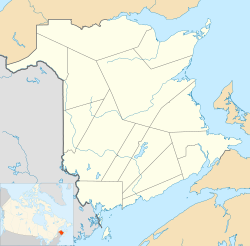Evergreen Peedamkee'jos | |
|---|---|
| Meto'mqwijuig Mountain (2012).jpg Meto'mqwijuig Mountain | |
| Coordinates: 47°53′00″N66°54′00″W / 47.883333°N 66.9°W | |
| Country | |
| Province | |
| County | Restigouche |
| Parish | Eldon |
| Electoral Districts Federal | Madawaska—Restigouche |
| Provincial | Restigouche West |
| Government | |
| • Type | Local service district |
| Time zone | UTC-4 (AST) |
| • Summer (DST) | UTC-3 (ADT) |
| Postal code(s) |
|
| Area code | 506 |
| Access Routes | |
Evergreen is an unincorporated community in Restigouche County, New Brunswick, Canada. [1]
